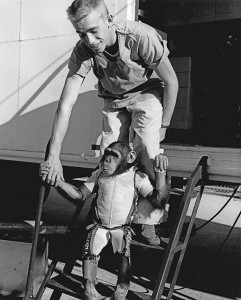HAM the Astrochimp
“He was every bit the astronaut that any of the Mercury 7 were.”

Before humans could be sent into space, scientists needed to know if they could function in weightlessness. NASA had conducted tests with mice and a monkey, but then turned to chimpanzees, animals that could be trained to perform specific tasks.
Enter HAM (an acronym derived from Holloman AeroMedical Research Laboratories, where the chimp was sent for training), formerly known as Number 65, who was born in Cameroon 54 years ago this month. HAM, one of six chimpanzees-in-training, made his successful flight in January 1961. After his record-setting flight, HAM was transferred to the National Zoo.
"He was every bit the astronaut that any of the Mercury 7 were," says Benjamin Lawless in Animals Aloft, a Smithsonian Channel special based upon National Air and Space Museum archivist Allan Janus' book of the same name. (Lawless is the former chief designer of exhibits at the National Museum of American History.) "He did exactly what all the Mercury 7 astronauts did, and they went on to become congressmen and senators and presidents of universities. Poor HAM was put in jail. He arrived at the National Zoo in 1963, and he was still there in 1980."
When Melanie Bond, one of the very first female trainers, arrived at the Zoo in 1973, she thought HAM seemed a very lonely guy. "One of the things I would ask, was, 'Do you want me to tickle your toes?' And he would offer his feet, but he would also seem to be very reluctant, and kind of whimper and cry a little bit.... I would tickle his toes and he would laugh, and he really seemed to enjoy that. until years later I learned that part of his training involved having his feet strapped on metal plates, and if he didn't perform the behaviors they wanted him to perform, he would receive an electric shock. That memory stayed with him years after."
HAM's friends at the Zoo sought a better home for him, and found the perfect spot at the North Carolina Zoological Park in Asheboro, where he could live with other chimps. He was transferred there in 1980.
Lawless remembers the transfer clearly. "He was being transferred to Asheboro by an Air Force plane, because the Air Force still considered him a member of their group. When we started to push that cage toward the airplane, this young captain said 'Stop! Wait a minute!' And he lined all those guys up on either side of that runway, and as we pushed HAM along to the airplane, they saluted him. It was his only parade. Which was lovely, I thought."
HAM found romance and an extended family at Asheboro. He died of heart disease in 1983; his remains are buried at the International Space Hall of Fame in New Mexico.